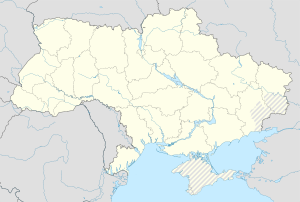Mykolayiv Shipyard
 | |
| Formerly | 61 Kommunara Shipbuilding Plant |
|---|---|
| Company type | Shipyard |
| Industry | Shipbuilding |
| Predecessors | Nikolayev Admiralty; Russud; Andre Marti (North) Yard; Shipyard No. 200 (in the name of 61 Communards); Shipyard No. 445 (in the name of 61 Communards) |
| Founded | 1788 in Mykolaiv (Nikolaev), Russian Empire |
| Owner | state |
| Parent | Ukroboronprom |
| Website | http://www.shipyard61.com.ua/start-eng.html |
46°58′35″N 32°00′15″E / 46.9764°N 32.0042°E
Mykolayiv Shipyard (Ukrainian: Миколаївський суднобудівний завод) is a major shipyard owned by state and located in Mykolaiv, Ukraine. In modern times,[when?] the shipyard has been most commonly referred to as Mykolayiv North Shipyard.[1] Until 2017, it was known as the Shipyard named after 61 Communards.
History
In 1788, there was found as part of the Imperial Russian admiralties Nikolaev Admiralty on the banks of the Ingul river approximately 55 miles (89 km) inland from the Black Sea .[2] The following year the first 44-gun frigate, St. Nicholas, was launched. In 1827-1829 the neighboring Kherson Admiralty was closed down and transferred to be merged with one in Nikolaev (Mykolaiv). In 1851, Admiral M.P. Lazarev ordered the first considerable reconstruction of the shipyard.[2]
In 1910 the government decided to stop building battleships and close the shipyard, but it was reopened in the following year as the French-owned Russian Shipbuilding Corporation (Russud).[3] The name Russud comes from combining the word Russian and the word Sudostroitel'nyj (lit. Shipbuilding).
Between 1911 and 1914, two building berths with slip-ways, an assembling and welding workshop, a number of buildings and an outfitting wharf were built on the left bank of the Ingul River.[2]
Early in the Soviet era, the shipyard was renamed to the Andre Marti (North) Yard.[1] In 1931, the shipyard was named after 61 Communards. From then on, torpedo-boats, destroyers, light cruisers, submarines; naval supply vessels, including rescue vessels of various purposes equipped with deep-water operation systems were built.[2] It was named Shipyard No. 200 (in the name of 61 Communards) on 30 December 1936 and was renumbered as Shipyard No. 445 when it reopened after the end of World War II.[4]
Facilities and Services

The shipyard is about 11.4 square kilometers (4.4 sq mi), with a building area of about 476.5 square meters (5,129 sq ft) and 1-2 Kone four-legged cranes. Production capacities of the shipyard are concentrated in 286 industrial buildings and 165 industrial structures.[2]
Soviet-built ships
Cruisers
- Kronshtadt-class battlecruiser: 1 (along with Admiralty Shipyard)
- Kara-class cruiser: 7 (whole class)
- Slava-class cruiser: 4 (whole class)
Destroyers
- Skoryy-class destroyer: 18 (all names started with B)
Submarines
- Shchuka-class submarine, Series V-modified: 3
- Shchuka-class submarine, Series V-modified-2: 4
- Shchuka-class submarine, Series X: 8
Notable vessels
The following vessels were constructed at this shipyard. The list is not all inclusive.[5]
| Name | Laid down | Launched | Displacement | Class (NATO) | Type |
|---|---|---|---|---|---|
| Vitse-admiral Popov | 1874 | 1875 | 3,600 tons | Ironclad Monitor | |
| Pamiat' Merkuria | 1901 | 1902 | 6,645 tons | Bogatyr | Protected Cruiser |
| Imperator Aleksandr III | 1911 | 1914 | 23,413 tons | Imperatritsa Mariya | Battleship |
| Imperatritsa Ekaterina Velikaya | 1911 | 1913 | 24,644 tons | Imperatritsa Mariya | Battleship |
| Imperatritsa Mariya | 1911 | 1913 | 23,413 tons | Imperatritsa Mariya | Battleship |
| Imperator Nikolai I | 1915 | 1916 | 27,830 tons | Battleship | |
| Soobrazitelny | 1939 | 1939 | 1,727 tons | Storozhevoy (Project 7U) | Destroyer |
| Ognevoy | 1939 | 1940 | 2,125 tons | Ognevoy (Project 30) | Destroyer |
| Gnevny | 1957 | 1958 | 3,500 tons | Kanin (Project 57A) | Destroyer |
| Uporny | 1958 | 1959 | 3,500 tons | Kanin (Project 57A) | Destroyer |
| Boyky | 1959 | 1959 | 3,500 tons | Kanin (Project 57A) | Destroyer |
| ORP Warszawa | 1966 | 1968 | 4,950 tons | Kashin (Project 61MP) | Large Anti-submarine Ship (Guided Missile Cruiser - western typing) |
| Nikolayev | 1968 | 1969 | 9,700 tons | Kara (Project 1134B Berkut B) | Large Anti-submarine Ship (Guided Missile Cruiser - western typing) |
| Slava[6][7] | 1976 | 1979 | 12,490 tons | Slava (Project 1164 Atlant) | Guided Missile Cruiser |
- Note: NATO class only shown if applicable; classes of vessels launched before 1949 are provided as originally designated. The name of the ship provided is the name given when launched–some ships may have since been renamed.
Notes
Bibliography
- Breyer, Siegfried (1992). Soviet Warship Development: Volume 1: 1917-1937. London: Conway Maritime Press. ISBN 0-85177-604-3.
- Harrison, Mark; Cooper, Julian; Dexter, Keith & Rodionov, Ivan (2003). The Numbered Factories and Other Establishments of the Soviet Defence Industry Complex, 1927 to 1968, Part I, Factories & Shipyards (Version 8 ed.). Warwick, UK: University of Warwick, Department of Economics.
- Hauner, Milan L. (Spring 2004). "Stalin's Big-Fleet Program". Naval War College Review. LVII (2). Archived from the original on 2017-04-28. Retrieved 2016-12-29.
- Polmar, Norman (1983). Guide to the Soviet Navy (3rd ed.). Annapolis, Maryland: Naval Institute Press. ISBN 0-87021-239-7.
- Polmar, Norman & Noot, Jurrien (1991). Submarines of the Russian and Soviet Navies, 1718–1990. Annapolis, Maryland: Naval Institute Press. ISBN 0-87021-570-1.
- Treadea, John & Sozaev, Eduard (2010). Russian Warships in the Age of Sail, 1696–1860: Design, Construction, Careers and Fates. Barnsley, UK: Seaforth Publishing. ISBN 978-1-84832-058-1.

